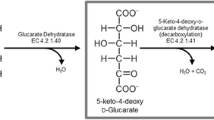Abstract
A bacterium which degrades urethane compounds was isolated and identified as Rhodococcus equi strain TB-60. Strain TB-60 degraded toluene-2,4-dicarbamic acid dibutyl ester (TDCB) and accumulated toluene diamine as the degradation product. The enzyme which cleaves urethane bond in TDCB was strongly induced by acetanilide. The purified enzyme (urethane hydrolase) was found to be homogeneous on sodium dodecyl sulfate–polyacrylamide gel electrophoresis. The molecular weight was estimated to be 55 kDa. The optimal temperature and pH were 45°C and 5.5, respectively. The enzyme hydrolyzed aliphatic urethane compound as well as aromatic ones. The activity was inhibited by HgCl2, p-chrolomercuribenzoic acid, and phenylmethylsulfonyl fluoride, suggesting that cysteine and/or serine residues play an important role in the activity. The enzyme catalyzed the hydrolysis of anilides, amides, and esters as well as TDCB. It was characterized as a novel amidase/esterase, differing in some properties from other known amidases/esterases.




Similar content being viewed by others
Abbreviations
- EPC:
-
Ethyl N-phenylcarbamate
- HDCB:
-
Hexamethylene dicarbamic acid dibutyl ester
- HDA:
-
Hexamethylene diamine
- HFBA:
-
Heptafluorobutyric acid anhydride
- MDCB:
-
Methylene bisphenyl dicarbamic acid dibutyl ester
- PMSF:
-
Phenylmethylsulfonyl fluoride
- PUR:
-
Polyurethane
- TDA:
-
Toluene diamine
- TDI:
-
Tolylene diisocyanate
References
Akutsu Y, Nakajima-Kambe T, Nomura N, Nakahara T (1998) Purification and properties of a polyester polyurethane degrading enzyme from Comamonas acidovorans TB-35. Appl Environ Microbiol 64:62–67
Alt J, Heymann E, Krisch K (1975) Characterization of an inducible amidase from Pseudomonas acidovorans AE1. Eur J Biochem 53:357–369
Altschul SF, Gish W, Miller W, Myers EW, Lipman DJ (1990) Basic local alignment search tool. J Mol Biol 215:403–410
Derbyshire MK, Karns JS, Kearney PC, Nelson JO (1987) Purification and characterization of an N-methylcarbamate pesticide hydrolyzing enzyme. J Agric Food Chem 35:871–877
Engelhardt G, Wallnöfer PR, Plapp R (1973) Purification and properties of an aryl acylamidase of Bacillus sphaericus, catalyzing the hydrolysis of various phenylamide herbicides and fungicides. Appl Microbiol 26:709–718
Goodfellow M (1986) Genus Rhodococcus Zopf 1891, 28AL. In: Sneath PHA, Mair NS, Sharpe ME, Holt JG (eds) Bergey's manual of systematic bacteriology, vol 2. Williams & Wilkins, Baltimore, MD, pp 1472–1481
Hammond PM, Christopher PP, Scawen MD (1983) Purification and properties of aryl acylamidase from Pseudomonas fluorescens ATCC 39004. Eur J Biochem 132:651–655
Hayatsu M, Nagata T (1993) Purification and characterization of carbaryl hydrolase from Blastbacter sp. strain M501. Appl Environ Microbiol 59:2121–2125
Hayatsu M, Mizutani A, Hashimoto M, Sato K, Hayano K (2001) Purification and characterization of carbaryl hydrolase from Arthrobacter sp. RC100. FEMS Microbiol Lett 201:99–103
Heyman E, Mentlein R, Rix H (1981) Hydrolysis of aromatic amides as assay for carboxylesterase-amidases. Methods Enzymol 77:405–409
Howard GT (2002) Biodegradation of polyurethane: a review. Int Biodeterior Biodegrad 49:245–252
Karns JS, Tomasek PH (1991) Carbofuran hydrolase—purification and properties. J Agric Food Chem 39:1004–1008
Kay MJ, McCabe RW, Morton LHG (1993) Chemical and physical changes occurring in polyester polyurethane during biodegradation. Int Biodeterior Biodegrad 31:209–225
Kobashi K, Takebe S, Sakai T (1990) Urethane-hydrolyzing enzyme from Citrobacter sp. Chem Pharm Bull 38:1326–1328
Laemmli UK (1970) Cleavage of structural proteins during the assembly of the head of bacteriophage T4. Nature 227:680–685
Lowry OH, Rosebrough NJ, Farr AL, Randall RJ (1951) Protein measurement with the folin phenol reagent. J Biol Chem 193:265–275
Martens R, Domsch KH (1981) Microbial degradation of polyurethane forms and isocyanate based polyureas in different media. Water Air Soil Pollut 15:503–509
Marty JL, Vouges J (1987) Purification and properties of a phenylcarbamate herbicide degrading enzyme of Pseudomonas alcaligenes isolated from soil. Agric Biol Chem 51:3287–3294
Mulbry WW, Eaton RW (1991) Purification and characterization of the N-methylcarbamate hydrolase from Pseudomonas strain CRL-OK. Appl Environ Microbiol 57:3679–3682
Nakajima-Kambe T, Onuma F, Akutsu Y, Nakahara T (1997) Determination of the polyester polyurethane breakdown products and distribution of the polyurethane degrading enzyme of Comamonas acidovorans strain TB-35. J Ferment Bioeng 83:456–460
Nakajima-Kambe T, Shigeno-Akutsu Y, Nomura N, Onuma F, Nakahara T (1999) Microbial degradation of polyurethanes, polyester polyurethanes and polyether polyurethanes. Appl Microbiol Biotechnol 51:134–140
Owen S, Otani T, Masaoka S, Ohe T (1996) The biodegradation of low-molecular-weight urethane compounds by a strain of Exophiala jeanselmei. Biosci Biotechnol Biochem 60:244–248
Pohlenz H-D, Boidol W, Schüttke I, Streber WR (1992) Purification and properties of an Arthrobacter oxydans P52 carbamate hydrolase specific for the herbicide phenmedipham and nucleotide sequence of the corresponding gene. J Bacteriol 174:6600–6607
Santerre JP, Labow RS, Duguay DG, Erfle D, Adams GA (1994) Biodegradation evaluation of polyether and polyester–urethanes with oxidative and hydrolytic enzymes. J Biomed Mater Res 28:1187–1199
Shimizu S, Ogawa J, Chung MC, Yamada H (1992) Purification and characterization of a novel enzyme, arylalkyl acylamidase, from Pseudomonas putida Sc2. Eur J Biochem 209:375–382
Skarping G, Dalene M, Mathiasson L (1988) Trace analysis of airborne 1, 6-hexamethylenediisocyanate and the related aminoisocyanate and diamine by glass capillary gas chromatography. J Chromatogr 435:453–468
Yoshioka H, Nagasawa T, Yamada H (1991) Purification and characterization of aryl acylamidase from Nocardia globerula. Eur J Biochem 199:17–24
Zhao CJ, Kobashi K (1994) Purification and characterization of iron-containing urethanase from Bacillus licheniformis. Biol Pharm Bull 17:773–778
Acknowledgement
We thank Mr. Daisuke Nishiguchi of Mitsui Takeda Chemicals Co., Ltd. for supplying urethane compounds.
Author information
Authors and Affiliations
Corresponding author
Rights and permissions
About this article
Cite this article
Akutsu-Shigeno, Y., Adachi, Y., Yamada, C. et al. Isolation of a bacterium that degrades urethane compounds and characterization of its urethane hydrolase. Appl Microbiol Biotechnol 70, 422–429 (2006). https://doi.org/10.1007/s00253-005-0071-1
Received:
Revised:
Accepted:
Published:
Issue Date:
DOI: https://doi.org/10.1007/s00253-005-0071-1




